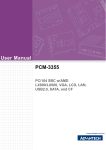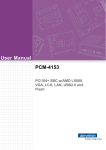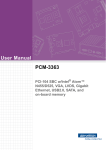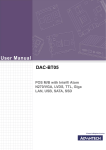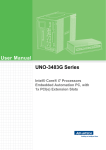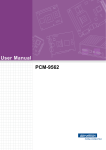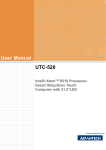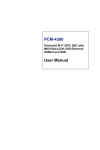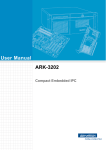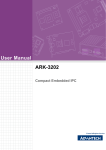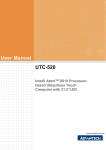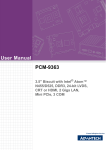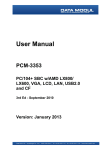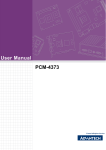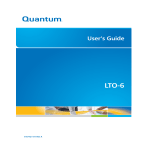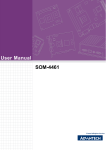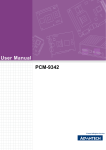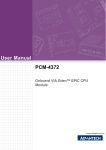Download User Manual PCM-9361
Transcript
User Manual PCM-9361 3.5" Biscuit with Intel® Atom N270/VGA, LVDS, TTL, Giga LAN, USB, SATA, SSD Copyright The documentation and the software included with this product are copyrighted 2009 by Advantech Co., Ltd. All rights are reserved. Advantech Co., Ltd. reserves the right to make improvements in the products described in this manual at any time without notice. No part of this manual may be reproduced, copied, translated or transmitted in any form or by any means without the prior written permission of Advantech Co., Ltd. Information provided in this manual is intended to be accurate and reliable. However, Advantech Co., Ltd. assumes no responsibility for its use, nor for any infringements of the rights of third parties, which may result from its use. Acknowledgements Award is a trademark of Award Software International, Inc. IBM, PC/AT, PS/2 and VGA are trademarks of International Business Machines Corporation. Intel and Atom are trademarks of Intel Corporation. Microsoft Windows® is a registered trademark of Microsoft Corp. RTL is a trademark of Realtek Semi-Conductor Co., Ltd. ESS is a trademark of ESS Technology, Inc. UMC is a trademark of United Microelectronics Corporation. SMI is a trademark of Silicon Motion, Inc. Creative is a trademark of Creative Technology LTD. CHRONTEL is a trademark of Chrontel Inc. All other product names or trademarks are properties of their respective owners. PCM-9361 User Manual Part No. 2006936110 Edition 1 Printed in China March 2009 ii Product Warranty (2 years) Advantech warrants to you, the original purchaser, that each of its products will be free from defects in materials and workmanship for two years from the date of purchase. This warranty does not apply to any products which have been repaired or altered by persons other than repair personnel authorized by Advantech, or which have been subject to misuse, abuse, accident or improper installation. Advantech assumes no liability under the terms of this warranty as a consequence of such events. Because of Advantech’s high quality-control standards and rigorous testing, most of our customers never need to use our repair service. If an Advantech product is defective, it will be repaired or replaced at no charge during the warranty period. For outof-warranty repairs, you will be billed according to the cost of replacement materials, service time and freight. Please consult your dealer for more details. If you think you have a defective product, follow these steps: 1. Collect all the information about the problem encountered. (For example, CPU speed, Advantech products used, other hardware and software used, etc.) Note anything abnormal and list any onscreen messages you get when the problem occurs. 2. Call your dealer and describe the problem. Please have your manual, product, and any helpful information readily available. 3. If your product is diagnosed as defective, obtain an RMA (return merchandize authorization) number from your dealer. This allows us to process your return more quickly. 4. Carefully pack the defective product, a fully-completed Repair and Replacement Order Card and a photocopy proof of purchase date (such as your sales receipt) in a shippable container. A product returned without proof of the purchase date is not eligible for warranty service. 5. Write the RMA number visibly on the outside of the package and ship it prepaid to your dealer. Technical Support and Assistance 1. 2. Visit the Advantech web site at www.advantech.com/support where you can find the latest information about the product. Contact your distributor, sales representative, or Advantech's customer service center for technical support if you need additional assistance. Please have the following information ready before you call: – Product name and serial number – Description of your peripheral attachments – Description of your software (operating system, version, application software, etc.) – A complete description of the problem – The exact wording of any error messages iii PCM-9361 User Manual Packing List Before installation, please ensure the following items have been shipped: Item Part Number 1 PCM-9361 SBC 1 Startup manual 1 Utility CD 1 mini jumper pack Cables Part Number Description 1700006291 SATA cable 30cm 1700060202 CABLE 6P-6P-6P PS/2 KB & MOUSE 20cm 1700000265 WIRE ATX-20P(M)/12P(F) 10CM 1703100152 Audio Cable 10P 2.0mm 15cm 1701140201 FLAT 14PIN 2.0mm Secondary Port 9PIN(M)20cm 1703100121 Wire 10P 12cm IDC 2.0mm For USB 2 PORT 1700260250 Cable 25cm 25P to 26P ASS'Y LPT Port 2.0mm Ordering information Model Number Description PCM-9361FG-S6A1E Atom N270 SBC,Giga-LAN,LCD,SATA,PCI-104 Optional accessories Model Number Description 1700001531 FLAT CABLE 34P-2.54 mm/26P-2. 0mm 30 cm(LPT to FDD) PCM-9361 User Manual iv Contents Chapter Chapter 1 General Introduction ...........................1 1.1 1.2 1.3 Introduction ............................................................................................... 2 Product Features....................................................................................... 2 Specifications ............................................................................................ 3 1.3.1 Functional Specification ................................................................ 3 1.3.2 Mechanical Specification .............................................................. 5 1.3.3 Electrical Specification .................................................................. 6 1.3.4 Environmental Specification.......................................................... 6 2 H/W installation....................................9 2.1 Jumpers .................................................................................................. 10 2.1.1 Jumper list................................................................................... 10 Table 2.1: Jumper list ................................................................ 10 2.1.2 Jumper Settings .......................................................................... 10 Table 2.2: J1: Audio Power ....................................................... 10 Table 2.3: J2: AT/ATX Power Setting........................................ 10 Table 2.4: J3: PCI VIO Setting .................................................. 11 Table 2.5: J4: Clear CMOS ....................................................... 11 Table 2.6: J5: LCD Power ......................................................... 11 Table 2.7: J6: COM2 Setting ..................................................... 12 Connectors.............................................................................................. 12 2.2.1 Connector list .............................................................................. 12 Table 2.8: Connector List .......................................................... 12 2.2.2 Connector Settings ..................................................................... 13 Mechanical .............................................................................................. 15 2.3.1 Jumper and Connector Locations ............................................... 15 Figure 2.1 Jumper and Connector layout (Component side)..... 15 Figure 2.2 Jumper and Connector layout (Solder side) ............. 16 2.3.2 Board Dimensions....................................................................... 16 Figure 2.3 Board Dimension layout (Component side).............. 16 Figure 2.4 Board Dimension layout (Solder side) ...................... 17 Figure 2.5 Board Dimension layout (Coastline) ......................... 17 2.2 2.3 Chapter 3 BIOS settings .....................................19 3.1 3.2 BIOS Introduction.................................................................................... 20 BIOS Setup ............................................................................................. 20 3.2.1 Main Menu .................................................................................. 21 3.2.2 Standard CMOS Features .......................................................... 22 3.2.3 Advanced BIOS Features ........................................................... 23 3.2.4 Advanced Chipset Features........................................................ 25 3.2.5 Integrated Peripherals................................................................. 26 3.2.6 Power Management Setup ......................................................... 28 3.2.7 PnP/PCI Configurations .............................................................. 30 3.2.8 PC Health Status ........................................................................ 31 3.2.9 Frequency/Voltage Control ......................................................... 32 3.2.10 Load Optimized Defaults............................................................. 33 3.2.11 Set Password.............................................................................. 33 3.2.12 Save & Exit Setup ....................................................................... 35 3.2.13 Quit Without Saving .................................................................... 35 v PCM-9361 User Manual Chapter 4 Extension I/O Installation ................. 37 4.1 PCI-104................................................................................................... 38 Appendix A PIN Assignments .............................. 39 A.1 PIN Assignments .................................................................................... 40 Table A.1: CN1: Audio ............................................................... 40 Table A.2: CN2: Internal USB.................................................... 40 Table A.3: CN3: Internal USB.................................................... 41 Table A.4: CN4: SATA............................................................... 41 Table A.5: CN5: SATA............................................................... 42 Table A.6: CN6: Power Switch (Low Active )............................ 42 Table A.7: CN7: PCI-104 -12 V Input ........................................ 42 Table A.8: CN8: AT/ATX Power Input ....................................... 43 Table A.9: CN9: PCI-104 ........................................................... 43 Table A.10:CN10: 36 bits LVDS Panel ....................................... 47 Table A.11:CN11: LPT................................................................ 48 Table A.12:CN12: GPIO ............................................................. 49 Table A.13:CN13: 18 bits TTL Panel .......................................... 49 Table A.14:CN14: Inverter Power Output ................................... 51 Table A.15:CN15: HDD & PWR LED.......................................... 51 Table A.16:CN16: SMBus........................................................... 52 Table A.17:CN17: COM2............................................................ 52 Table A.18:CN18: LAN ............................................................... 53 Table A.19:CN19: CPU FAN (+5V) ............................................ 53 Table A.20:CN20: External USB................................................. 54 Table A.21:CN21: PS2 ............................................................... 54 Table A.22:CN22: COM1............................................................ 55 Table A.23:CN23: VGA............................................................... 55 Table A.24:CN24: CF ................................................................. 56 Table A.25:CN25: DDR2 SO-DIMM H=6.5mm........................... 58 Table A.26:CN26: Reset Button ................................................. 63 PCM-9361 User Manual vi Chapter 1 1 General Introduction This chapter gives background information on the PCM-9361. Sections include: Introduction Product Feature Specifications 1.1 Introduction The PCM-9361 is a 3.5" SBC (Single Board Computer) with Embedded Intel® Atom N270 1.6 GHz Processor. PCM-9361 can support DDR2 memory up to 2GB, has five USB 2.0 compatible ports, Giga LAN (1000 Mbps) interface, LVDS/TTL interface, HD (High Definition) Audio, and one PCI-104 expansion connector. The PCM-9361 also supports two SATA and two COM ports. 1.2 Product Features General CPU: Intel® Atom Processor N270 1.6 GHz System Chipset Intel® 945GSE +ICH7M BIOS: AWARD® 4 Mbit Flash BIOS System Memory: DDRII 400/533 MHz SDRAM up to 2GB SSD: Supports CompactFlash® Card TYPE I/II Watchdog Timer: Single chip Watchdog 255-level interval timer, setup by software Expansion Interface: Supports PCI-104 device Battery: Lithium 3 V/210 mAH I/O I/O Interface: 2 x SATA(Supports 150MB/s), 1 x K/B, 1 x KB/mouse, 1 x RS232, 1 x RS232/422/485, 1 x LPT, 1 x FDD (share with LPT) USB: 5 x USB 2.0 compliant Ports Audio: High Definition Audio (HD),Line-in, Line out, Mic-in GPIO: 8-bit general purpose input/output Ethernet Chipset: Realtek 8110SC Speed: 1000 Mbps Interface: 1 x RJ45 Standard: Compliant with IEEE 802.3, IEEE 802.3u, IEEE 802.3x, IEEE 802.ab. Display Chipset: Intel® 945GSE Memory Size: Up to 64 MB of dynamic video memory allocation Resolution: - CRT display Mode: Supports QXGA Up to 2048 x 1536 - TTL display Mode: Up to 800 x 600 TTL LCD: Supports 18-bit TTL LCD LVDS LCD: Supports 36-bit LVDS LCD Dual Display: - CRT + LVDS (36-bits) - CRT + TTL (18-bits) PCM-9361 User Manual 2 Chapter 1 1.3 Specifications 1.3.1 Functional Specification Chipset (945GSE) Memory Graphic and Video Controllers 945GSE GMCH Supports 2 GB maximum memory One 64-bit wide DDR2 SDRAM single channel Supports DDR2 400, DDR2 533, 256 Mb, 512 Mb 1 Gb and 2Gb DDR2 technology Only x8, x16 DDR2 devices with 4 or 8 banks Support for DDR2 On-Die Termination(ODT) Socket: SODIMM Socket: 1. 200-pin SODIMM socket type *1 945GSE Intel 3.5 Gen Integrated Graphic Engine DVMT 3.0 (Dynamic Video Memory Technology) Display Dynamic Power Saving Technology 2.0 (Intel DPST 2.0) Intel Smart 2D Display Technology (S2DDT) 3 PCM-9361 User Manual General Introduction Processor Intel® Atom™ Processor N270 Intel® Atom TM N270 at 1.6 GHz with 512 KB L2 cache 437-pin FCBGA8 package FSB: 533 MHz Bus Ratio: 12 Manufacturing Technology: 45nm Thermal Design Power: 2.5 W Thermal Specification: 90°C VID Voltage Range: 90 V-1.100 V Chipset (ICH7M) IDE Interface ICH7M support Single, independent IDE signal channel Supports one CF device H.D. Codec ALC888 I/F ICH7M support Support for HD codec Supports up to 2.1 channel of PCM audio output Connectors:Line-out, Line-in, Mic-in: Pin header 2*5P (M) 2.0 mm Concurrent PCI/PCIe Bus Controller MIO 2.0 ICH7M chip support PCI 2.1 compliant 32-bit 3.3 V 33 MHz PCI interface with 5 V tolerant inputs Supports PC/PCI DMA PCI Express 1.0a compliant SATA Connector ICH7M support Supports independent DMA operation on two ports Supports data transfer rates of up to 1.5 Gb/s (150 MB/s) Operation of AHCI using memory space Supports several optional sections of the Serial ATA II SATA connectors: Connector: Serial ATA II 7 pins 1.27 mm x 2 USB Interface ICH7M support Supports 5 USB 2.0 ports which are high-speed, fullspeed, and low-speed capable Port-routing logic determines whether a USB port is controlled by UHCI or EHCI USB Connector:(USB1~4) 2 set 5 x 2-pin Hirose DF13 type Power Management ICH7M support Fully supports ACPI (Advanced Configuration and Power Interface) 2.0 Supports S1, S5 PCI CLKRUN# and PME# support SMI# (System Management Interrupt) generation BIOS ICH7M support Phoenix 4M bit Flash BIOS, supports Plug & Play, APM 1.2/ ACPI 1.1. FWH Type Socket: 32-pin PLCC socket PCM-9361 User Manual 4 LAN Realtek 8110SC. Compliant with IEEE 802.3, IEEE 802.3u, IEEE 802.3x, IEEE 802.ab. Support 1000Mbps. Connectors: Phone Jack RJ45 8P 90D(F) Serial ports SMSC3114 (LPC Super I/O) supports: 2 full function serial ports. High Speed NS16C550A Compatible UARTs with Data rates to 1.5Mbps Support IRQ Sharing among serial ports. RS-485 Auto Direction Control Mode Connectors:COM1(RS-232), DB-9 COM2(RS-232/ 422/485 with auto-flow control), 14-pin 2.0 mm 2 x 7 Box Header Parallel port SMSC SCH 3114 supports (LPC Super I/O). LPT interface connector: 26-pin flat-cable connector Keyboard/Mouse connectors SMSC SCH 3114 supports (LPC Super I/O). PS/2 Keyboard and Mouse interface. Connector: Mini-Din 6P at coastline GPIO Intel ICH7M supports. 8-Bit GPIO. 5 V tolerance I/Os. Connectors: 10 pins 2.0mm pin header. Battery backup 2 pin wafer box for external Battery on board 1.3.2 Mechanical Specification 1.3.2.1 Dimension (mm) L146.00 mm * W102 mm 1.3.2.2 Height on Top (mm) 18.80 mm 1.3.2.3 Height on Bottom (mm) 6.65 mm (CF Socket) 5 PCM-9361 User Manual General Introduction Graphic and Video Controllers 945GSE Intel 3.5 Gen Integrated Graphic Engine CRT: Supports QXGA Up to 2048 x 1536, TTL: Up to 640 x 480, 800 x 600 LVDS: Support 2 channel 36-bit LVDS panel, LVDS connector : Hirose DF13 type 40 pin TTL connector : Hirose DF13 type 40 pin CRT connector : D-SUB15 at coastline Chapter 1 Other chipset 1.3.2.4 Weight (g) with Heatsink 0.85 g 1.3.3 Electrical Specification 1.3.3.1 Power Supply Voltage Voltage requirement with AT/ATX Power: AT: +5 VDC ±5% ATX: +12 VDC ±5% +5 VDC ±5%, +5 V Standby for ATX mode 1.3.3.2 Power Supply Current Supply Current (ATX) CPU : Intel Atom N270 1.6 GHz XP Mode ATX 5V 12 V Typical 1.90 A 0.07 A Suspend 1.36 A 0.06 A Max Load 2.38 A 0.09 A 1.3.3.3 RTC Battery Typical Voltage : 3.0 V Nomal discharge capacity : 210 mAh 1.3.4 Environmental Specification 1.3.4.1 Operating Temperature Operating temperature: 0 ~ 60°C (32~140°F) * Tested under 60°C chamber temperature with 0.23 m/s air flow. 1.3.4.2 Operating Humidity Operating Humidity:10% ~ 90% Relative Humidity, non-condensing 1.3.4.3 Storage Temperature Standard products (0 ~ 60°C) Storage temperature: -20~70°C 1.3.4.4 Storage Humidity Standard products (0 ~ 60°C) Relative Humidity: 95% @ 60°C PCM-9361 User Manual 6 Chapter 1 General Introduction PCM-9361 User Manual 7 PCM-9361 User Manual 8 Chapter 2 2 H/W installation This chapter explains the setup procedures of the PCM-9361 hardware, including instructions on setting jumpers and connecting peripherals, switches, indicators and mechanical drawings. Be sure to read all safety precautions before you begin the installation procedure. 2.1 Jumpers 2.1.1 Jumper list Table 2.1: Jumper list J1 Audio Power J2 AT/ATX Power Setting J3 PCI VIO Setting J4 Clear CMOS J5 LCD Power J6 COM2 Setting 2.1.2 Jumper Settings Table 2.2: J1: Audio Power Part Number 1653003101 Footprint JH3X1V-2M Description PIN HEADER 3*1P 180D(M) 2.0mm DIP SQUARE W/O Pb Setting Function (1-2) +12 V to +5 V LDO (2-3) +5 V Table 2.3: J2: AT/ATX Power Setting Part Number 1653002101 Footprint JH2X1V-2M Description PIN HEADER 2*1P 180D(M)SQUARE 2.0mm DIP W/O Pb Setting Function NC ATX Power (1-2) AT Power PCM-9361 User Manual 10 Part Number 1653003101 Footprint JH3X1V-2M Description PIN HEADER 3*1P 180D(M) 2.0mm DIP SQUARE W/O Pb Setting Function (1-2) +5 V (2-3) +3.3 V Chapter 2 Table 2.4: J3: PCI VIO Setting H/W installation Table 2.5: J4: Clear CMOS Part Number 1653003101 Footprint JH3X1V-2M Description PIN HEADER 3*1P 180D(M) 2.0mm DIP SQUARE W/O Pb Setting Function (1-2) Normal (2-3) Clear COMS Table 2.6: J5: LCD Power Part Number 1653003101 Footprint JH3X1V-2M Description PIN HEADER 3*1P 180D(M) 2.0mm DIP SQUARE W/O Pb Setting Function (1-2) +5 V (2-3) +3.3 V 11 PCM-9361 User Manual Table 2.7: J6: COM2 Setting Part Number 1653003260 Footprint HD_3x2P_79 Description PIN HEADER 3*2P 180D(M) 2.0mm SMD SOUARE PIN Setting Function (1-2) RS232 (3-4) RS485 (5-6) RS422 2.2 Connectors 2.2.1 Connector list Table 2.8: Connector List CN1 Audio CN2 Internal USB CN3 Internal USB CN4 SATA CN5 SATA CN6 Power Switch (Low Active ) CN7 PCI-104 -12V Input CN8 AT/ATX Power Input CN9 PCI-104 CN10 36 bits LVDS Panel CN11 LPT CN12 GPIO CN13 18 bits TTL Panel CN14 Inverter Power Output CN15 HDD & PWR LED CN16 SMBus CN17 COM2 CN18 LAN CN19 CPU FAN (+5V) CN20 External USB CN21 PS2 CN22 COM1 CN23 VGA CN24 CF CN25 DDR2 SO-DIMM H=6.5mm CN26 Reset Button PCM-9361 User Manual 12 2.2.2.1 Audio Interface (CN1) Audio Port Connectors One 5 x 2 pin box header for Audio connector. These audio connectors are used for audio devices. The audio jacks are differentiated by color for different audio sound effects. 2.2.2.3 SATA Connector (CN4, CN5) PCM-9361 supports Serial ATA via two connectors (CN4, CN5). Data transfer rates up to 150 MB/s are possible, enabling very fast data and file transfer, and independent DMA operation on two ports. 2.2.2.4 Power Switch Connector (CN6) One 2 x 1 pin wafer box (CN6) for power switch. 2.2.2.5 Power Connectors (CN8) Main power connector, +5 V, +12 V or 5 V only PCM-9361 supports ATX and AT modes Use ATX power cable (PN: 1700000265 ATX-20P (M)/12P (F) 10 CM) connect CN8, it's changed from 12pin to 20pin, provides 5 V and 12 V and other PS_ON signals. 2.2.2.6 LVDS LCD Panel Connector (CN10) The board supports 2 channel 18-bit LVDS LCD panel display. Users can connect to a 36-bit LVDS LCD. 2.2.2.7 GPIO (General Purpose Input Output) (CN12) The board supports 8-bit GPIO through GPIO connector. The 8 digital in and out-puts can be programmed to read or control devices, with input or output defined. The default setting is 4 bits input and 4 bits output. 2.2.2.8 TTL LCD Panel Connector (CN13) The board supports 18-bit TTL LCD panel displays. 2.2.2.9 Power & HDD LED Indicator (CN15) The HDD LED indicator for hard disk access is an active low signal (24 mA sink rate). Power supply activity LED indicator. 2.2.2.10 SMBus Connector (CN16) One 4 x 1 pin wafer box (CN16) supports SMBus interface. 13 PCM-9361 User Manual H/W installation 2.2.2.2 USB Connectors (CN2, CN3, CN20) The board provides up to Five USB (Universal Serial Bus) ports. This gives complete Plug and Play, and hot attach/detach for up to 127 external devices. The USB interface comply with USB specification Rev. 2.0 which supports 480 Mbps transfer rate, and are fuse protected. There are 5 x 2 pin 180D (M) connectors for internal use, 4 x USB ports CN2, CN3 and one external USB port CN20. You will need an adapter cable if you use a standard USB connector. On one end the adapter cable has a 5 x 2-pin connector with a foolproof connection to prevent it from being plugged in the wrong way and on the other end a USB connector. * CN3 conflicts with PC/104 connector of PC/104+ module, please plug PCI-104 module only or remove PC/104 connector of PC/104+ module. Chapter 2 2.2.2 Connector Settings 2.2.2.11 COM Port Connector (CN17, CN22) The PCM-9361 provides 2 serial ports (COM1 and COM2). One 7*2P PIN HEADER (CN17) for COM2 output; and one DB-9 connector for COM1(CN22) COM RS-232/422/485 setting (J6) COM2 can be configured to operate in RS-232, RS-422, or RS-485 mode. This is done via J6. J6 COM2 Setting Setting Function (1-2) RS232 (3-4) RS485 (5-6) RS422 It provides connections for serial devices (ex: a mouse, etc.) or a communication network. You can find the pin assignments for the COM port connector in Appendix A. 2.2.2.12 Ethernet configuration(CN18) 10/100/1000 Mbps connections are made via RJ-45 connectors. The board is equipped with 1 high performance PCI Ethernet interface which is fully compliant with IEEE 802.3u 100Base-T & IEEE 802.3ab 1000Base-T. It is supported by all major network operating systems. 2.2.2.13 Fan Power Supply Connector (CN19) Provides +5 V power supply to CPU cooling fan. 2.2.2.14 Keyboard and PS/2 mouse connector (CN21) The board provides a keyboard connector that supports both a keyboard and a PS/2 style mouse. In most cases, especially in embedded applications, a keyboard is not used. If the keyboard is not present, the standard PC/AT BIOS will report an error or fail during power-on self-test (POST) after a reset. The product's BIOS standard setup menu allows you to select "All, But Keyboard" under the "Halt On" selection. This allows no-keyboard operation in embedded system applications, without the system halting under POST. 2.2.2.15 CRT display connector (CN23) The CRT display connector is a DB15 connector used for conventional CRT displays. 2.2.2.16 CompactFlash (CN24) The CompactFlash card shares a Primary IDE channel which can be enabled/disabled via the BIOS settings. 2.2.2.17 DDRII DIMM Socket (CN25) One 200-pin/H6.5 mm DDRII DIMM socket (CN25) supports DDRII 400/533 MHz up to 2 GB. 2.2.2.18 Power Reset button (CN26) Momentarily pressing the reset button will activate a reset. The switch should be rated for 10 mA, 5 V. PCM-9361 User Manual 14 Chapter 2 2.3 Mechanical 2.3.1 Jumper and Connector Locations H/W installation Figure 2.1 Jumper and Connector layout (Component side) 15 PCM-9361 User Manual Figure 2.2 Jumper and Connector layout (Solder side) 2.3.2 Board Dimensions Figure 2.3 Board Dimension layout (Component side) PCM-9361 User Manual 16 Chapter 2 H/W installation Figure 2.4 Board Dimension layout (Solder side) Figure 2.5 Board Dimension layout (Coastline) 17 PCM-9361 User Manual PCM-9361 User Manual 18 Chapter 3 BIOS settings 3 3.1 BIOS Introduction AwardBIOS 6.0 is a full-featured BIOS provided by Advantech to deliver superior performance, compatibility, and functionality to industrial PCs and embedded boards. Its many options and extensions let you customize your products to a wide range of designs and target markets. The modular, adaptable AwardBIOS 6.0 supports the broadest range of third-party peripherals and all popular chipsets, plus Intel, AMD, nVidia, VIA, and compatible CPUs from 386 through Pentium, AMD Geode, K7 and K8 (including multiple processor platforms), and VIA Eden C3 and C7 CPUs. You can use Advantech's utilities to select and install features that suit your needs and your customers' needs. 3.2 BIOS Setup The PCM-9361 system has AwardBIOS 6.0 built-in, which includes a CMOS SETUP utility that allows users to configure settings as required or to activate certain system features. The CMOS SETUP saves configuration settings in the CMOS RAM of the motherboard. When the system power is turned off, the onboard battery supplies the necessary power to the CMOS RAM so that settings are retained. To access the CMOS SETUP screen, press the <Del> button during the power-on BIOS POST (Power-On Self Test). CMOS SETUP Navigation and Control Keys: < ↑ >< ↓ >< ← >< → > Move to highlight item <Enter> Select Item <Esc> Main Menu - Start Quit sequence Sub Menu - Exit the current page and return to level above <Page Up/+> Increase the numeric value or make changes <Page Down/-> Decrease the numeric value or make changes <F1> General help, for Setup Sub Menu <F2> Item Help <F5> Load Previous Values <F7> Load Optimized Default <F10> Save all CMOS changes PCM-9361 User Manual 20 Press the <Del> key during startup to enter the BIOS CMOS Setup Utility; the Main Menu will appear on the screen. Use arrow keys to highlight the desired item, and press <Enter> to accept, or enter the sub-menu. Chapter 3 3.2.1 Main Menu BIOS settings Standard CMOS Features This setup page includes all the features for standard CMOS configuration. Advanced BIOS Features This setup page includes all the features for advanced BIOS configuration. Advanced Chipset Features This setup page includes all the features for advanced chipset configuration. Integrated Peripherals This setup page includes all onboard peripheral devices. Power Management Setup This setup page includes all the power management items. PnP/PCI Configurations This setup page includes PnP OS and PCI device configuration. PC Health Status This setup page includes the system auto-detect CPU and system temperature, voltage, and fan speed. Frequency/Voltage Control This setup page includes CPU host clock control, frequency ratio and voltage. Load Optimized Defaults This selection loads optimized values for best system performance configuration. Set Password Establish, change or disable passwords. Save & Exit Setup Save CMOS value settings to CMOS and exit BIOS setup. Exit Without Saving Abandon all CMOS value changes and exit BIOS setup. 21 PCM-9361 User Manual 3.2.2 Standard CMOS Features Date The date format is <weekday>, <month>, <day>, <year>. Weekday From Sun to Sat, determined and display by BIOS only Month From Jan to Dec. Day From 1 to 31 Year From 1999 through 2098 Time The times format in <hour> <minute> <second>, base on the 24-hour time. IDE Channel 0/1 Master/Slave IDE HDD Auto-Detection - Press "Enter" for automatic device detection. Drive A The Item identifies the types of floppy disk drive A or drive B None No floppy drive installed 360K, 5.25" 5.25 inch PC-type standard drive; 360K byte capacity 1.2M, 5.25" 5.25 inch AT-type high-density drive; 1.2M byte capacity 720K, 3.5" 3.5 inch double-sided drive; 720K byte capacity 1.44M, 3.5" 3.5 inch double-sided drive; 1.44M byte capacity 2.88M, 3.5" 3.5 inch double-sided drive; 2.88M byte capacity Halt on This item determines whether the computer will stop if an error is detected during power up. No Errors The system boot process will not stop for any error All Errors Whenever the BIOS detects a non-fatal error the system boot process will be stopped. All, But Keyboard The system boot process will not stop for a keyboard error, but will stop for all other errors. (Default value) PCM-9361 User Manual 22 All, But Disk/Key The system boot process will not stop for a keyboard or disk error, but will stop for all other errors. Base Memory Displays the amount of base (or conventional) memory installed in the system. Extended Memory Displays the amount of extended memory (above 1 MB in CPU's memory address map) installed in the system. Total Memory Displays the total system memory size. 3.2.3 Advanced BIOS Features CPU Feature This item allows the user to adjust CPU settings such as CPU ratio, VID and Thermal, and special features like XD flag. Hard Disk Boot Priority This item allows the user to select the boot sequence for system devices such as HDD, SCSI, and RAID. CPU L1 & L2 Cache [Enabled] This item allows user to enable CPU L2 cache and ECC checking function. CPU L3 Cache [Enabled] This item allows the user to enable/disable CPU L3 cache. Hyper-Threading Technology [Enabled] This item allows the user to enable/disable Hyper-threading support for the Intel® Pentium® 4 processor with HT Technology. 23 PCM-9361 User Manual BIOS settings The system boot process will not stop for a diskette error, but will stop for all other errors. Chapter 3 All, But Diskette Quick Power On Self Test [Enabled] This field speeds up the Power-On Self Test (POST) routine by skipping re-testing a second, third and fourth time. The default setting is enabled. First / Second / Third / Other Boot Drive Hard Disk Sets boot priority for the hard disk. CDROM Sets boot priority for CDROM. USB-FDD Sets boot priority for USB-FDD. USB-ZIP Sets boot priority for USB-ZIP. USB-CDROM Sets boot priority for USB-CDROM. LAN Sets boot priority for LAN. Disabled Disables this boot function. Boot Up NumLock Status [On] This item allows the user to activate the Number Lock key at system boot. Gate A20 Option [Fast] This item allows the user to switch on or off A20 control by port 92. Typematic Rate Setting This item allows the user to set the two typematic control items. This field controls the speed of – Typematic Rate (Chars/Sec) This item controls the speed at which the system registers auto repeated keystrokes. The eight settings are: 6, 8, 10, 12, 15, 20, 24 and 30. – Typematic Delay (Msec) This item sets the key press delay time before auto repeat begins. The four delay rate options are: 250, 500, 750 and 1000. Security Option [Setup] System System requires correct password before booting, and also before permitting access to the Setup page. Setup System will boot, but requires correct password before permitting access to Setup. (Default value) APIC Mode [Enabled] This item allows the user to enable/disable the "Advanced Programmable Interrupt Controller". APIC is implemented in the motherboard and must be supported by the operating system; it extends the number of IRQs available. MPS Version Control for OS [1.4] This item sets the operating system multiprocessor support version. OS Select For DRAM > 64 MB [Non-OS2] Select OS2 only if the system is running the OS/2 operating system with greater than 64 MB of RAM on the system. PCM-9361 User Manual 24 Chapter 3 3.2.4 Advanced Chipset Features BIOS settings Note! The "Advanced Chipset Features" screen controls the configuration of the board's chipset register settings and performance tuning - the options on this screen may vary depending on the chipset type. It is strongly recommended that only technical users make changes to the default settings. DRAM Timing Selectable [By SPD] This item enables users to set the optimal timings for items 2 through 5, system default setting of "By SPD" to follow the SPD information and ensure the system running in stable and optimal performance. CAS Latency Time [Auto] This item enables users to set the timing delay in clock cycles before SDRAM start a read command after receiving it. DRAM RAS# to CAS# Delay [Auto] This item enables users to set the timing of the transition from RAS (row address strobe) to CAS (column address strobe) as both rows and column are separately addressed shortly after DRAM is refreshed. DRAM RAS# Precharge [Auto] This item enables users to set the DRAM RAS# precharge timing, system default is setting to "Auto" to reference the data from SPD ROM. Precharge delay (tRAS) [Auto] This item allows user to adjust memory precharge time System Memory Frequency [Auto] This item allows user to adjust memory frequency to improvement performance. SLP_S4# Assertion Width [4 to 5 Sec] This item allow user to set the SLP_S4# Assertion Width. System BIOS Cacheable [Enabled] This item allows the system BIOS to be cached to allow faster execution and better performance. 25 PCM-9361 User Manual Video BIOS Cacheable [Disabled] This item allows the video BIOS to be cached to allow faster execution and better performance. Memory Hole At 15M-16M [Disabled] This item reserves 15MB-16MB memory address space to ISA expansion cards that specifically require the setting. Memory from 15MB-16MB will be unavailable to the system because of the expansion cards can only access memory at this area. PCI Express Root Port Func [Press Enter] This item allows the user to adjust the PCIE port to on, off, or auto. On-Chip Frame Buffer Size [8MB] This item allows the user to adjust on-chip graphics of memory buffer. DVMT Mode [DVMT] This item allows the user to adjust Intel's Dynamic Video Memory Technology (DVMT).Bios provide three option to choose (DVMT,FIXED and Both). DVMT/FIXED Memory Size [128MB] This item allows the user to adjust DVMT/FIXED graphics memory size. Boot Display [CRT] This item allows the user to decide which display mode to use for the boot display. Panel Type [ 640 x 480, 18bits] This item allows the user to adjust panel resolution. 3.2.5 Integrated Peripherals Note! The "Integrated Peripherals" screen controls chipset configuration for IDE, ATA, SATA, USB, AC97, MC97 and Super IO and Sensor devices. The options on this screen vary depending on the chipset. PCM-9361 User Manual 26 Onboard Device This item enables users to set the Onboard device status, includes enable USB, AC97, MC97 and LAN devices. Super IO Device This item enables users to set the Super IO device status, includes enable Floppy, COM, LPT, IR and control GPIO and Power fail status. USB Device Setting This item enables users to set the USB device type. Onboard Serial port 1 [ 3F8/IRQ4] This item allows the user to adjust serial port 1 address. Onboard Serial port 2 [ 2F8/IRQ3] This item allows the user to adjust serial port 2 address. SP 2 AutoFlow Control [ Disabled] This item allows the user to enable serial port 2 autoflow control function. Onboard Parallel Port [378/IRQ7] This item allows the user to adjust parallel port address and IRQ. Parallel Port Mode [Standard] This item allows the user to adjust parallel port mode. ECP Mode Use DMA [3] This item allows the user to adjust the ECP DMA resource. 27 PCM-9361 User Manual BIOS settings OnChip IDE Device This item enables users to set the OnChip IDE device status, including IDE devices and setting PIO and DMA access modes. Some chipsets support newer SATA devices (Serial-ATA). Chapter 3 3.2.6 Power Management Setup Note! The "Power Management Setup" screen allows configuration of the system for effective energy savings while still operating in a manner consistent with intended computer use. ACPI Function [Enabled] This item defines the ACPI (Advanced Configuration and Power Management) feature that makes hardware status information available to the operating system, and communicate PC and system devices for improving the power management. ACPI Suspend Type [S3 (STR)] This item allows user to select sleep state state when the computer is in suspend mode. S1 (POS) The suspend mode is equivalent to a software power down. S3 (STR) The system shuts down with the exception of a refresh current to the system memory. Run VGA BIOS if S3 Resume [Auto] This item allows the user to enable run VGA bios if system resume from S3. Power Management [Min Saving] This item allows user to select system power saving mode. Min Saving Minimum power management. Suspend Mode=1 hr. Max Saving Maximum power management. Suspend Mode=1 min. User Define Allows user to set each mode individually. Suspend Mode= Disabled or 1 min ~1 hr. PCM-9361 User Manual 28 V/H SYNC+Blank This option will cause the system to turn off vertical and horizontal synchronization ports and write blanks to the video buffer. Blank Screen This option only writes blanks to the video buffer. DPMS Initial display power management signaling. Video Off In Suspend [Yes] This item allows user to turn off video during system enter suspend mode. Suspend Type [Stop Grant] This item allows user to determine the suspend type. Modem use IRQ [3] This item allows user to determine the IRQ which the MODEM can use. Suspend Mode [1 Hour] This item allows user to determine the time of system inactivity, all devices except the CPU will be shut off. HDD Power Down Mode [15 Min] This item allows user to determine the time of system inactivity, the hard disk drive will be powered down. Soft-Off by PWR-BTTN [Instant-Off] This item allows the user to define the power button functions. Instant-Off Press the power button to power off instantly. Delay 4 Sec Press and hold the power button for 4 sec to power off. PWRON After PWR-Fail [Former-Sts] This item allows the user to select recovery after power fail function; this function depends on the chipset. Wake-Up by PCI card [Enabled] This item allows user to defines PCI cards to wake up the system from the suspend mode. Power On by Ring [Enabled] This item allows user to define the system will resume by activating of modem ring. Resume by Alarm [Disabled] This item allows user to enable and key in Date/time to power on system Disabled Disable this function. Enabled Enable alarm function to power on system Day (of month) Alarm 1-31 Time (HH:MM:SS) Alarm (0-23) : (0-59) : 0-59) 29 PCM-9361 User Manual BIOS settings Video Off Method [DPMS] This item allows the user to determine the manner in which the monitor is blanked. Chapter 3 3.2.7 PnP/PCI Configurations Note! This "PnP/PCI Configurations" option sets up the IRQ and DMA (both PnP and PCI bus assignments). Init Display First [PCI Slot] This item is setting for start up Video output from PCI or Onboard device. Reset Configuration Data [Disabled] This item allow user to clear any PnP configuration data stored in the BIOS. Resources Controlled By [Auto (ESCD)] – IRQ Resources This item allows you respectively assign an interruptive type for IRQ-3, 4, 5, 7, 9, 10, 11, 12, 14, and 15. – DMA Resources This item allows you respectively assign an interruptive type for DMA, 0, 1, 2, 3, 4, 5, 6, and 7. PCI VGA Palette Snoop [Disabled] The item is designed to solve problems caused by some non-standard VGA cards. A built-in VGA system does not need this function. INT Pin 1~8 Assignment [Auto] This item allows the user to select the interrupt request (IRQ) assigned to a device connected to the PCI interface on your system. Maximum Payload Size [4096] This item allows the user to adjust maximum TLP (Transaction Layer Packet) payload size. PCM-9361 User Manual 30 Chapter 3 3.2.8 PC Health Status BIOS settings Note! This "PC Health Status" page reports the thermal, fan and voltage status of the board. This page may vary according to the chipset installed. Current CPU Temperature [Show Only] This item displays current CPU temperature. FAN 1 Speed [Show Only] This item displays current system FAN(s) speed(s). VCC/ 2.5 V/ 5V/ 12V [Show Only] This item displays current CPU and system voltage. 31 PCM-9361 User Manual 3.2.9 Frequency/Voltage Control Note! The "Frequency/Voltage Control" screen controls the CPU host and PCI frequency. The options on this page vary depending on the chipset; items show up according to installed CPU capacities. CPU CIock Ratio [6X] This item enables users to set the CPU clock ratio by manually. Auto Detect PCI Clk [Enabled] This item enables users to set the PCI Clk either by automatic system detection or manually. Spread Spectrum [Disabled] This item enables users to set the spread spectrum modulation. CPU Host/SRC/PCI Clock [Defautl] This item enables users to set the CPUhost/SRC/PCI clock. PCM-9361 User Manual 32 Chapter 3 3.2.10 Load Optimized Defaults BIOS settings Note! "Load Optimized Defaults" loads the default system values directly from ROM. If the stored record created by the setup program should ever become corrupted (and therefore unusable), select Load Setup Defaults to have these default values load automatically for the next bootup. 3.2.11 Set Password Note! To enable this feature, you should first go to the "Advanced BIOS Features" menu, choose the Security Option, and select either System or Setup, depending on which aspects you want password protected. System requires a password both to boot the system and to enter Setup. Setup requires a password only to enter Setup. A password may be at most 8 characters long. 33 PCM-9361 User Manual To Establish Password 1. Choose the Set Password option from the CMOS Setup Utility Main Menu and press <Enter>. 2. When you see Enter Password, enter the desired password and press <Enter>. 3. At the Confirm Password prompt, retype the desired password, then press <Enter>. 4. Select Save to CMOS and exit, type <Y>, then <Enter>. To Change Password 1. Choose the Set Password option from the CMOS Setup Utility main menu and press <Enter>. 2. When you see Enter Password, enter the existing password and press <Enter>. 3. You will see the Confirm Password prompt, type it in again, and press <Enter>. 4. Select Set Password again, and at the Enter Password prompt, enter the new password and press <Enter>. 5. At the Confirm Password prompt, retype the new password, and press <Enter>. 6. Select Save to CMOS and exit, type <Y>, then <Enter>. To Disable a Password 1. Choose the Set Password option from the CMOS Setup Utility main menu and press <Enter>. 2. When you see the Enter Password prompt, enter the existing password and press <Enter>. 3. You will see Confirm Password, type it in again, and press <Enter>. 4. Select Set Password again, and at the Enter Password prompt, DO NOT enter anything - just press <Enter>. 5. At the Confirm Password prompt, again, DO NOT type in anything - just press <Enter>. 6. Select Save to CMOS and exit, type <Y>, then <Enter>. PCM-9361 User Manual 34 Chapter 3 3.2.12 Save & Exit Setup BIOS settings Note! Typing "Y" will quit the BIOS Setup Utility and save user setup values to CMOS. Typing "N" will return to BIOS Setup Utility. 3.2.13 Quit Without Saving Note! Typing "Y" will quit the BIOS Setup Utility without saving any changes to CMOS. Typing "N" will return to the BIOS Setup Utility. 35 PCM-9361 User Manual PCM-9361 User Manual 36 Chapter 4 Extension I/O Installation 4 4.1 PCI-104 Aim the pin connector to the footprint and apply force evenly. After applying force to the IPC connector, the footprint of the module / CPU board needs to be inserted correctly. After applying force to the connector, the footprint of the module / CPU board needs to be inserted correctly. PCM-9361 User Manual 38 Appendix A A PIN Assignments A.1 PIN Assignments Table A.1: CN1: Audio Part Number 1653205260 Footprint BH5X2SV Description BOX HEADER SMD 5*2 180D (M) 2.0mm Pin Pin Name 1 LOUTR 2 LINR 3 GND 4 GND 5 LOUTL 6 LINL 7 GND 8 GND 9 MIC1R 10 MIC1L Matching Cable : 1703100152 Table A.2: CN2: Internal USB Part Number 1653005260 Footprint HD_5x2P_79_N10 Description PIN HEADER 2*5P 180D(M) 2.0mm SMD IDIOT-PROOF Pin Pin Name 1 +5V 2 +5V 3 A_D- 4 B_D- 5 A_D+ 6 B_D+ 7 GND 8 GND 9 GND Matching Cable : 1703100121 PCM-9361 User Manual 40 Part Number 1653005260 Footprint HD_5x2P_79_N10 Description PIN HEADER 2*5P 180D(M) 2.0mm SMD IDIOT-PROOF Pin Pin Name 1 +5V 2 +5V 3 A_D- 4 B_D- 5 A_D+ 6 B_D+ 7 GND 8 GND 9 GND Matching Cable : 1703100121 Table A.4: CN4: SATA Part Number 1654002320 Footprint FOX_LD1107V-S33T5 Description Serial ATA 7P 1.27 90D(M) SMD LD1107V-S33T5 Pin Pin Name 1 GND 2 TX+ 3 TX- 4 GND 5 RX- 6 RX+ 7 GND 41 PCM-9361 User Manual Appendix A PIN Assignments Table A.3: CN3: Internal USB Table A.5: CN5: SATA Part Number 1654002320 Footprint FOX_LD1107V-S33T5 Description Serial ATA 7P 1.27 90D(M) SMD LD1107V-S33T5 Pin Pin Name 1 GND 2 TX+ 3 TX- 4 GND 5 RX- 6 RX+ 7 GND Table A.6: CN6: Power Switch (Low Active ) Part Number 1655302020 Footprint WF_2P_79_BOX_R1_D Description WAFER BOX 2P 180D(M) 2.0mm W/Lock Pin Pin Name 1 PSIN 2 GND Table A.7: CN7: PCI-104 -12 V Input Part Number 1653002101 Footprint JH2X1V-2M Description PIN HEADER 2*1P 180D(M)SQUARE 2.0mm DIP W/O Pb Pin Pin Name 1 -12 V 2 GND PCM-9361 User Manual 42 Part Number 1655412090 Footprint ATXCON-2X6V-42 Description Power CONN.6*2P 180D(M) DIP W/Fixed Lock Pin Pin Name 1 GND 2 +5V 3 +5V 4 GND 5 +5V 6 +5V 7 GND 8 GND 9 +5VSB 10 PSON# 11 GND 12 +12V Matching Cable : 1700000265 Table A.9: CN9: PCI-104 Part Number 00A0000020 1653130428 Footprint PC104-PCI-PLUS Description PCI-104 Pin Pin Name PA1 GND PA2 VI/O (+5V or +3.3V) PA3 AD05 PA4 C/BE0# PA5 GND PA6 AD11 PA7 AD14 PA8 +3.3V PA9 SERR# PA10 GND PA11 STOP# 43 PCM-9361 User Manual Appendix A PIN Assignments Table A.8: CN8: AT/ATX Power Input Table A.9: CN9: PCI-104 PA12 +3.3V PA13 FRAME# PA14 GND PA15 AD18 PA16 AD21 PA17 +3.3V PA18 IDSEL0 PA19 AD24 PA20 GND PA21 AD29 PA22 +5V PA23 REQ0# PA24 GND PA25 GNT1# PA26 +5V PA27 CLK2 PA28 GND PA29 +12V PA30 -12V PB1 NC PB2 AD02 PB3 GND PB4 AD07 PB5 AD09 PB6 VI/O (+5V or +3.3V) PB7 AD13 PB8 C/BE1# PB9 GND PB10 PERR# PB11 +3.3V PB12 TRDY# PB13 GND PB14 AD16 PB15 +3.3V PB16 AD20 PB17 AD23 PB18 GND PB19 C/BE3# PB20 AD26 PB21 +5V PB22 AD30 PB23 GND PB24 REQ2# PB25 VI/O (+5V or +3.3V) PB26 CLK0 PB27 +5V PB28 INTD# PCM-9361 User Manual 44 Appendix A PIN Assignments Table A.9: CN9: PCI-104 PB29 INTA# PB30 REQ3# PC1 +5V PC2 AD01 PC3 AD04 PC4 GND PC5 AD08 PC6 AD10 PC7 GND PC8 AD15 PC9 NC PC10 +3.3V PC11 LOCK# PC12 GND PC13 IRDY# PC14 +3.3V PC15 AD17 PC16 GND PC17 AD22 PC18 IDSEL1 PC19 VI/O (+5V or +3.3V) PC20 AD25 PC21 AD28 PC22 GND PC23 REQ1# PC24 +5V PC25 GNT2# PC26 GND PC27 CLK3 PC28 +5V PC29 INTB# PC30 GNT3# PD1 AD00 PD2 +5V PD3 AD03 PD4 AD06 PD5 GND PD6 M66EN PD7 AD12 PD8 +3.3V PD9 PAR PD10 NC PD11 GND PD12 DEVSEL# PD13 +3.3V PD14 C/BE2# PD15 GND 45 PCM-9361 User Manual Table A.9: CN9: PCI-104 PD16 AD19 PD17 +3.3V PD18 IDSEL2 PD19 IDSEL3 PD20 GND PD21 AD27 PD22 AD31 PD23 VI/O (+5V or +3.3V) PD24 GNT0# PD25 GND PD26 CLK1 PD27 GND PD28 RST# PD29 INTC# PD30 GND PCM-9361 User Manual 46 Part Number 1653920200 Footprint SPH20X2 Description *CONN. 40P 90D 1.25mm SMD WO/Pb DF13-40DP-1.25V Pin Pin Name 1 +5V or +3.3V 2 +5V or +3.3V 3 GND 4 GND 5 +5V or +3.3V 6 +5V or +3.3V 7 LVDS0_D0- 8 LVDS1_D0- 9 LVDS0_D0+ 10 LVDS1_D0+ 11 GND 12 GND 13 LVDS0_D1- 14 LVDS1_D1- 15 LVDS0_D1+ 16 LVDS1_D1+ 17 GND 18 GND 19 LVDS0_D2- 20 LVDS1_D2- 21 LVDS0_D2+ 22 LVDS1_D2+ 23 GND 24 GND 25 LVDS0_CLK- 26 LVDS1_CLK- 27 LVDS0_CLK+ 28 LVDS1_CLK+ 29 GND 30 GND 31 DDC_CLK 32 DDC_DAT 33 GND 34 GND 35 NC 36 NC 37 NC 38 NC 39 NC 40 NC 47 PCM-9361 User Manual Appendix A PIN Assignments Table A.10: CN10: 36 bits LVDS Panel Table A.11: CN11: LPT Part Number 1653213260 Footprint BH13X2SV Description BOX HEADER 13*2P 180D(M) 2.0mm SMD Pin Pin Name 1 STROBE# 2 AUTOFEED# 3 D0 4 ERROR# 5 D1 6 INIT# 7 D2 8 SLCT IN# 9 D3 10 GND 11 D4 12 GND 13 D5 14 GND 15 D6 16 GND 17 D7 18 GND 19 ACK# 20 GND 21 BUSY 22 GND 23 PE 24 GND 25 SLCT 26 NC PCM-9361 User Manual 48 Appendix A PIN Assignments Matching Cable : 1700260250 Table A.12: CN12: GPIO Part Number 1653005261 Footprint HD_5x2P_79_BOX Description PIN HEADER SMD 5*2P 180D(M) 2.0mm Pin Pin Name 1 +5V 2 GPIO4 3 GPIO0 4 GPIO5 5 GPIO1 6 GPIO6 7 GPIO2 8 GPIO7 9 GPIO3 10 GND Table A.13: CN13: 18 bits TTL Panel Part Number 1653920200 Footprint SPH20X2 Description *CONN. 40P 90D 1.25mm SMD WO/Pb DF13-40DP-1.25V Pin Pin Name 1 +5V 2 +5V 3 GND 4 GND 5 +3.3V 6 +3.3V 7 NC 8 GND 9 NC 10 NC 11 PD2 49 PCM-9361 User Manual Table A.13: CN13: 18 bits TTL Panel 12 PD3 13 PD4 14 PD5 15 PD6 16 PD7 17 NC 18 NC 19 PD10 20 PD11 21 PD12 22 PD13 23 PD14 24 PD15 25 NC 26 NC 27 PD18 28 PD19 29 PD20 30 PD21 31 PD22 32 PD23 33 GND 34 GND 35 SHFCLK 36 FLM (V-SYNC) 37 M/DE 38 LP (H-SYNC) 39 NC 40 ENVEE PCM-9361 User Manual 50 Part Number 1655305020 Footprint WHL5V-2M Description WAFER BOX 2.0mm 5P 180D(M) W/LOCK Pin Pin Name 1 +12V 2 GND 3 ENABKL 4 VBR 5 +5V Table A.15: CN15: HDD & PWR LED Part Number 1655306020 Footprint WHL6V-2M Description WAFER BOX 2.0mm 6P 180D(M) W/LOCK Pin Pin Name 1 +5V 2 GND 3 Power LED+ 4 Power LED- 5 HDD LED+ 6 HDD LED- 51 PCM-9361 User Manual Appendix A PIN Assignments Table A.14: CN14: Inverter Power Output Table A.16: CN16: SMBus Part Number 1655904020 Footprint FPC4V-125M Description Wafer SMT 1.25mmS/T type 4P 180D(M) 85205-04001 Pin Pin Name 1 GND 2 SMB_DAT 3 SMB_CLK 4 +5V Table A.17: CN17: COM2 Part Number 1653207260 Footprint HD_7x2_79_BOX Description BOX HEADER SMD 7*2P 180D(M) 2.0mm Pin Pin Name 1 DCD# 2 DSR# 3 RXD 4 RTS# 5 TXD 6 CTS# 7 DTR# 8 RI# 9 GND 10 GND 11 422/485TX+ 12 422/485TX- 13 422RX+ 14 422RX- Matching Cable : 1701140201 PCM-9361 User Manual 52 Part Number 1652000174 Footprint RJ45-P62P071AX9 Description PhoneJack RJ45 14P 90D(F) W/Xfam P26@P07-1AX9 Pin Pin Name 1 TX+(10/100) 2 TX-(10/100) 3 RX+(10/100) 4 NC 5 NC 6 RX-(10/100) 7 NC 8 NC Table A.19: CN19: CPU FAN (+5V) Part Number 1655303020 Footprint WHL3V-2M Description WAFER BOX 2.0mm 3P 180D w/LOCK Pin Pin Name 1 Speed 2 +5V 3 GND 53 PCM-9361 User Manual Appendix A PIN Assignments Table A.18: CN18: LAN Table A.20: CN20: External USB Part Number 1654904105 Footprint USB-V-4A Description USB CON. 4P 90D(F) DIP A TYPE RoHS Pin Pin Name 1 +5V 2 D- 3 D+ 4 GND Table A.21: CN21: PS2 Part Number 1654003199 Footprint CONTEK_MQN3261F1G400 Description MINIDIN 6P Short body W/Shielding90D(F) DIP Pin Pin Name 1 KBDAT 2 MSDAT 3 GND 4 +5V 5 KBCLK 6 MSCLK Matching Cable : 1700060202 PCM-9361 User Manual 54 Part Number 1654000056 Footprint DBCOM-VM5MS Description D-SUB CON. 9P 90D(M)DIP 070241MR009S200ZU SUYIN Pin Pin Name 1 DCD# 2 RXD 3 TXD 4 DTR# 5 GND 6 DSR# 7 RTS# 8 CTS# 9 RI# Table A.23: CN23: VGA Part Number 1654000055 Footprint DBVGA-VF5MS Description D-SUB Conn. 15P 90D(F) DIP 070242FR015S200ZU Pin Pin Name 1 RED 2 GREEN 3 BLUE 4 NC 5 GND 6 GND 7 GND 8 GND 9 NC 10 GND 11 NC 12 DDAT 13 HSYNC 14 VSYNC 15 DCLK 55 PCM-9361 User Manual Appendix A PIN Assignments Table A.22: CN22: COM1 Table A.24: CN24: CF Part Number 1653000106 Footprint CF_50P_N7E50-H516RA-50 Description CF HEADER 50P 90D(M)SMD typeII N7E50-H516RA-50 Pin Pin Name 1 GND 2 D03 3 D04 4 D05 5 D06 6 D07 7 CS0# 8 GND 9 GND 10 GND 11 GND 12 GND 13 +5V 14 GND 15 GND 16 GND 17 GND 18 A02 19 A01 20 A00 21 D00 22 D01 23 D02 24 NC 25 CD2# 26 CD1# 27 D11 28 D12 29 D13 30 D14 31 D15 32 CS1# 33 VS1# 34 IORD# 35 IOWR# PCM-9361 User Manual 56 Appendix A PIN Assignments Table A.24: CN24: CF 36 WE# 37 IREQ 38 +5V 39 CSEL# 40 VS2# 41 RESET 42 IORDY 43 INPACK# 44 REG# 45 DASP# 46 PDIAG# 47 D08 48 D09 49 D10 50 GND 57 PCM-9361 User Manual Table A.25: CN25: DDR2 SO-DIMM H=6.5mm Part Number 1651000068 Footprint DDR-SODIMM-RVS65 Description SKT DIMM 200P DDR2 H=6.5mm RVS SMD 1612773-4 Pin Pin Name 1 VREF 2 GND 3 GND 4 DQ59 5 DQ63 6 DQ58 7 DQ62 8 GND 9 GND 10 DM7 11 DQS#7 12 GND 13 DQS7 14 DQ57 15 GND 16 DQ56 17 DQ61 18 GND 19 DQ60 20 DQ51 21 GND 22 DQ50 23 DQ55 24 GND 25 DQ54 26 DM6 27 GND 28 GND 29 DQS#6 30 CK1 31 DQS6 32 CK1# 33 GND 34 GND 35 DQ53 36 DQ49 37 DQ52 38 DQ48 39 GND 40 GND 41 GND 42 GND PCM-9361 User Manual 58 Appendix A PIN Assignments Table A.25: CN25: DDR2 SO-DIMM H=6.5mm 43 DQ47 44 DQ43 45 DQ46 46 DQ42 47 GND 48 GND 49 DQS#5 50 NC 51 DQS5 52 DM5 53 GND 54 GND 55 DQ45 56 DQ41 57 DQ44 58 DQ40 59 GND 60 GND 61 DQ39 62 DQ35 63 DQ38 64 DQ34 65 GND 66 GND 67 DM4 68 DQS#4 69 NC 70 DQS4 71 GND 72 GND 73 DQ37 74 DQ33 75 DQ36 76 DQ32 77 GND 78 GND 79 CKE0 80 CKE1 81 +1.8V 82 +1.8V 83 NC 84 NC 85 BA2 86 NC 87 +1.8V 88 +1.8V 89 A12 59 PCM-9361 User Manual Table A.25: CN25: DDR2 SO-DIMM H=6.5mm 90 A11 91 A9 92 A7 93 A8 94 A6 95 +1.8V 96 +1.8V 97 A5 98 A4 99 A3 100 A2 101 A1 102 A0 103 +1.8V 104 +1.8V 105 A10 106 BA1 107 BA0 108 RAS# 109 WE# 110 SCS#0 111 +1.8V 112 +1.8V 113 CAS# 114 ODT0 115 SCS#1 116 A13 117 +1.8V 118 +1.8V 119 ODT1 120 NC 121 GND 122 GND 123 DQ31 124 DQ27 125 DQ30 126 DQ26 127 GND 128 GND 129 DQS#3 130 DM3 131 DQS3 132 GND 133 GND 134 DQ25 135 DQ29 136 DQ24 PCM-9361 User Manual 60 Appendix A PIN Assignments Table A.25: CN25: DDR2 SO-DIMM H=6.5mm 137 DQ28 138 GND 139 GND 140 DQ19 141 DQ23 142 DQ18 143 DQ22 144 GND 145 GND 146 DQS#2 147 DM2 148 DQS2 149 GND 150 GND 151 DQ21 152 DQ17 153 DQ20 154 DQ16 155 GND 156 GND 157 DQ15 158 DQ11 159 DQ14 160 DQ10 161 GND 162 GND 163 NC 164 CK0 165 GND 166 CK0# 167 DQS#1 168 GND 169 DQS1 170 DM1 171 GND 172 GND 173 DQ13 174 DQ9 175 DQ12 176 DQ8 177 GND 178 GND 179 DQ7 180 DQ3 181 DQ6 182 DQ2 183 GND 61 PCM-9361 User Manual Table A.25: CN25: DDR2 SO-DIMM H=6.5mm 184 GND 185 DM0 186 DQS#0 187 GND 188 DQS0 189 DQ5 190 GND 191 DQ4 192 DQ1 193 GND 194 DQ0 195 SDA 196 GND 197 SCL 198 SA0 199 +3.3V 200 SA1 PCM-9361 User Manual 62 Part Number 1601003501 Footprint SW-PT-035-C Description PUSH SW SMD 4P 12V 50mA WO/Pb EVQPSR02K Pin Pin Name 1 RESET# 2 RESET# 3 GND 4 GND 63 PCM-9361 User Manual Appendix A PIN Assignments Table A.26: CN26: Reset Button www.advantech.com Please verify specifications before quoting. This guide is intended for reference purposes only. All product specifications are subject to change without notice. No part of this publication may be reproduced in any form or by any means, electronic, photocopying, recording or otherwise, without prior written permission of the publisher. All brand and product names are trademarks or registered trademarks of their respective companies. © Advantech Co., Ltd. 2009







































































